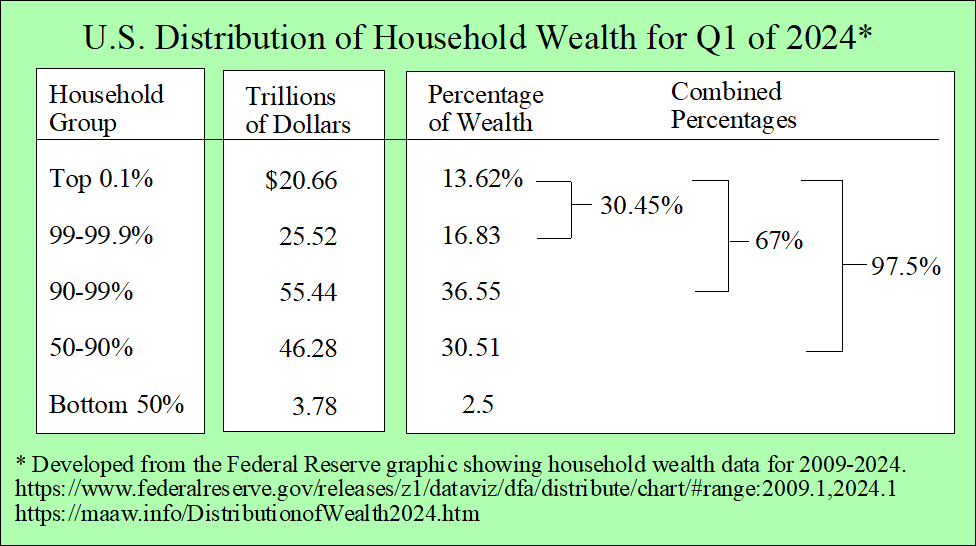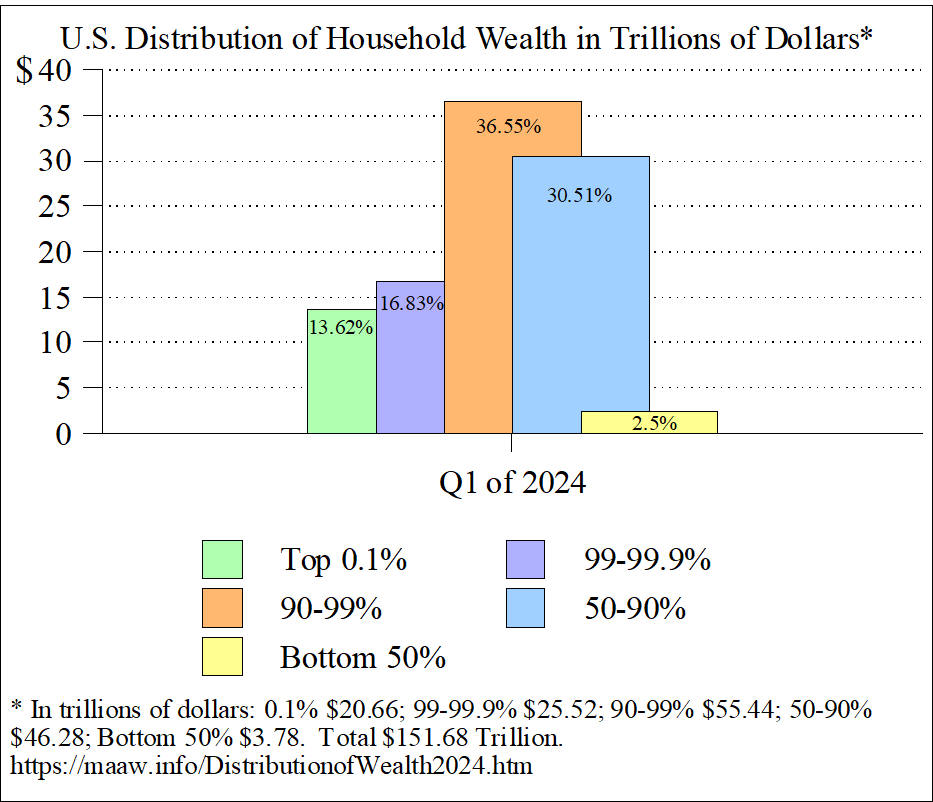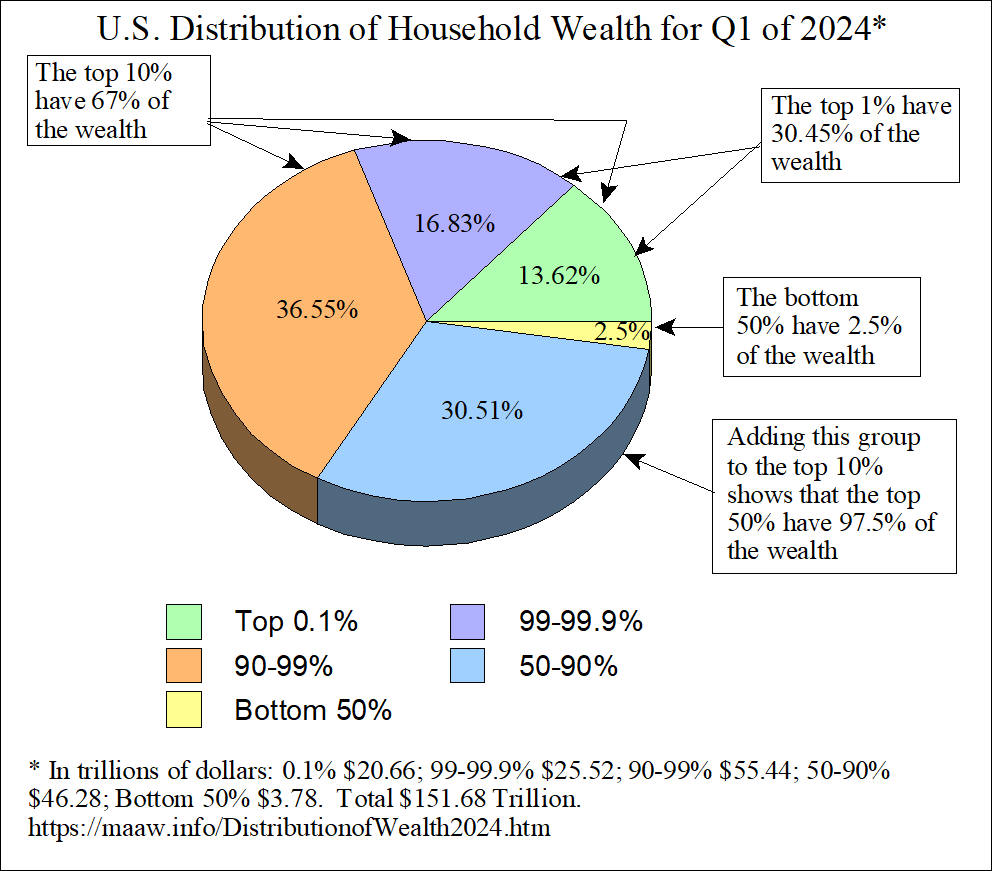
Provided by James R. Martin, Ph.D., CMA
Professor Emeritus, University of South Florida
Economics Main Page | Political Issues Main Page
Introduction and Purpose
My main purpose for developing this note is to point out the major problem in the U.S. economic system. It's not inflation, immigration, healthcare, the federal deficit, jobs, climate change, civil rights, national security, taxes, guns, crime, welfare, or civil liberties. These have been and continue to be problems, but our major problem is systemic inequality, and our unwillingness to do little if anything about it.
Why are so many people unhappy with our system of capitalism?
I developed the following graphics from a Federal Reserve illustration showing the distribution of household wealth for 2009- Q1 of 2024.1 The first graphic shows the distribution of wealth for five household groups starting with 1/10 of 1 percent of households who have 13.62% of the wealth. The second group includes the remaining part of the top 1% of households (99-99.9%) who have 16.83% of the wealth. Together those two groups make up 1% of the households and have 30.45% of the wealth. Adding the wealth of the third group (90-99% of households) shows that the top 10% of households have 67% of the wealth. Adding the 4th group (the middle class) makes up the top 50% of households who have 97.5% of the wealth. The bottom 50% of households have the remaining 2.5% of the wealth.

The second graphic shows the wealth percentages for the five household groups, but doesn't combine the groups.

The pie chart in the third graphic combines the groups to show the wealth held by the top 1 percent, top 10 percent, and top 50 percent of households. The remaining 2.5 percent is squeezed in to show the wealth held by the bottom 50 percent of households.

Can the problem with our system of capitalism be fixed or reduced?
The graphic illustrations above show the systemic inequalities that have been created by our system of capitalism and make it easy to see why so many Americans are unhappy with our system. Capitalism's wealth distribution problem cannot be fixed or eliminated, but there are ways to make the system more equitable. For example, Milanovic explains the reasons there is so much inequality in Chapter 2 of Capitalism Alone. In Chapter 5 he discusses some policies that would lead to a more equitable system of income distribution, less concentration of wealth and income from capital, and an improvement in intergenerational income mobility. These include changes in taxes, education, and citizenship rights.
Inequality is our major problem because it leads to or exacerbates many of our other problems mentioned in the introduction to this note, e.g., healthcare, crime, welfare, and the narrow tax base. It also increases political polarization and populist nationalism, lowers economic growth because wealthier households spend less than poorer households, weakens trust in public institutions, undermines democratic governance, and feeds higher future income inequality through the capital income and inheritances of the wealthier households.
Economic inequality might also reduce the cooperation that is essential for the functioning of our complex economy, produce high income individuals or groups that have disproportionate power to direct society's productive resources into uses of their choice, create inequality of opportunity for higher education, occupational training and the development of innate capabilities. It also creates the possibility that the most innately competent individuals will not occupy the most responsible positions in our system. In addition, high income individuals will likely posses disproportionate power to control political, educational, religious, and other agencies of social importance.
As I have explained in other notes, the way to solve or reduce the adverse effects of any of our problems is not in the Republican (now Trumpian) party's concept of limited government. There needs to be a balance between public and private, and between consumption and investment, and a system of limited government cannot provide that balance. The Republican support for short term consumption maximization is at odds with what is needed for economic success. What is required is a willingness and ability to make long-run investments in skills, education, knowledge, and infrastructure with a focus on sustainable development. Democrats support these objectives. Republicans do not.
_____________________________________________
1 The Federal Reserve illustration showing the distribution of Household Wealth 2009- Q1 of 024.
Related summaries:
Buchanan, M. 2002. Wealth happens. Harvard Business Review (April): 49-54. (Buchanan describes a universal law of wealth based on a network effect that appears to have some important implications for economic policy). (Note).
Martin, J. R. Not dated. Why I vote for Democrats!
Milanovic, B. 2019. Capitalism, Alone: The Future of the System That Rules the World. Harvard University Press. (Summary).
Oser, J. 1963. The Evolution of Economic Thought. Harcourt, Brace & World, Inc. (Summary).
Porter, M. E. and M. R. Kramer. 2011. Creating shared value: How to reinvent capitalism and unleash a wave of innovation and growth. Harvard Business Review (January/February): 62-77. (Summary).
Rosenfeld, G. D. (Editor) and J. Ward (Editor). 2023. Fascism in America: Past and Present. Cambridge University Press. (Summary).
Stanley, J. 2018. How Fascism Works: The Politics of Us and Them. Random House. (Summary).
Thurow, L. C. 1996. The Future of Capitalism: How Today's Economic Forces Shape Tomorrow's World. William Morrow and Company. (Summary).